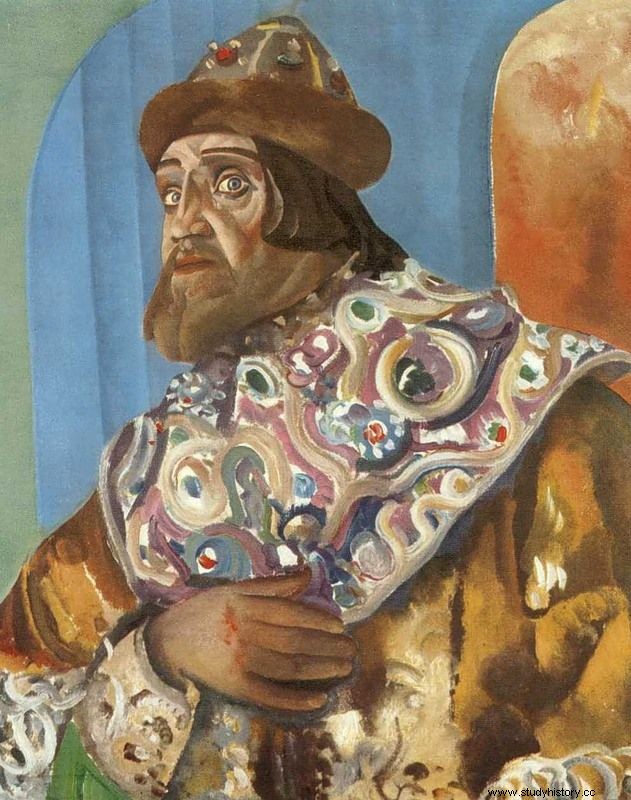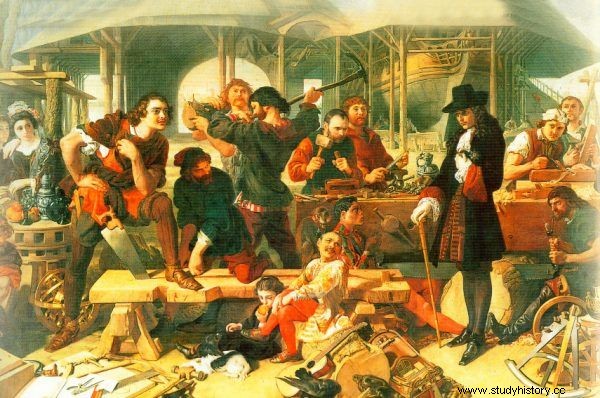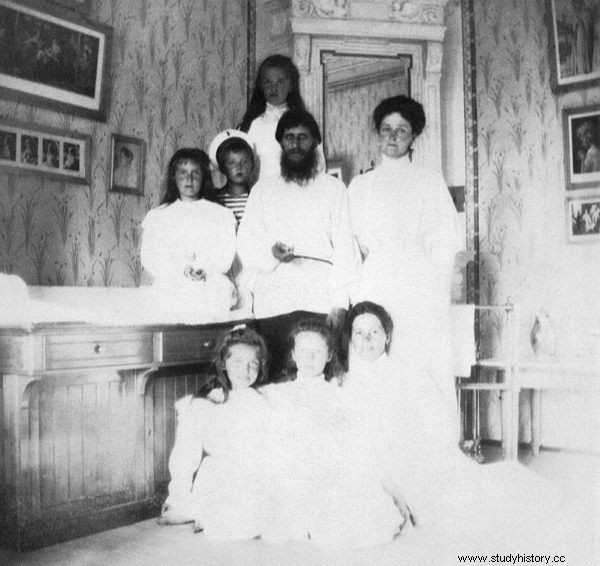Does a clove hurt? The tsar himself can tear it out with blacksmith pincers! The venereal disease? The quack will recommend diving in horse dung. Do you think a good birth will help you survive smallpox? You don't even know how wrong you are ... Rest assured, you wouldn't want to get sick in Russia!
What was the level of treatment in the tsarist state? Let the words of Antoni Ferdynand Ossendowski testify to this, as he visited a lot of the empire in its declining phase. In the villages of St. Petersburg, Pskov and Siberia, things happened in which our stories about the lawlessness of folk doctors seem ridiculous.
Here in Manuiłów, in the St. Petersburg governorate, a certain Sokołow was famous as a doctor in several poviats. A group of people suffering from leprosy, abdominal typhus and venereal diseases came to him once. Sokolow threw the leper into a barrel with hot water and herbs , covered it with rags, painted strange marks on the barrel with tar and muttered spells that repeated the word "Nostradamus".
After an hour, a fainted leper was taken out of the barrel; it was red, like a boiled crayfish, with eyes in a pole. His wounds on his mouth, nose and hands seemed even more terrible and hideous - Ossendowski writes.

Summoning Nostradamus in spells as a way to heal a leper? Well, it's not the most bizarre method of "healing", or at least not very harmful ... Portrait of Nostradamus from his prophecy collection published in 1666 (source:public domain).
Sokolov put Venerykos in a pile of horse dung for 3-5 days, into which he also stuck flags with spells. The healer also coped well with typhus patients.
He put people feverish and shaken by shivering in the snow, wrapped them in linen and tied them up. Then, fed the patient with hot bread mixed with powder from dried cockroaches, he placed 13 hot bricks on his stomach . When one of the patients died, a doctor from St. Petersburg finally brought Sokołów to trial.

In the legs, cockroaches, because you will be powdered and served to fever to eat. Mr and Mrs cockroach, "Public Health Image Library" (source:public domain).
This is what it looked like a little over a hundred years ago in the Russian provinces. What must have happened before, it is scary to think. Of course, the rich in big cities had better than in the villages where Sokołów "prowled". Even in metropolises, progress was painstakingly achieved, the more so as the crowned heads thought mainly about themselves.
Stars from the West
In the Middle Ages, manuscripts devoted to, inter alia, herbal medicine were written. But then and in the following centuries they were available only to the chosen ones:educated, mainly clergy.
No wonder that ordinary people asked for help. Because educated doctors initially appeared in Moscow and its vicinity only with guests from the West. On top of that, they risked a lot. For example, the Venetian Jew Leo was sentenced to death in 1490 after failing to heal the foot of a Moscow prince . That didn't sound very appealing.
Nevertheless, during the reign of Ivan the Terrible, a group of doctors, surgeons and pharmacists agreed to come from the West. Also in the 16th century, the first medical publication was published in Russia - based on the Polish collection of Latin medical treatises.
No wonder, medicine stood at a higher level in the Republic of Poland - we had such professionals as, for example, Wojciech Oczko, a graduate of the Academy of Krakow, a specialist in therapeutic water therapy and the fight against syphilis.
Successive tsars also took care of their health - of course their own - based on foreign "transfers". Here, in 1586, Tsar Fyodor I asked the British diplomat, Jerome Horsey, to secretly bring a doctor and a midwife to Russia to take care of Tsarist Irina, who had a problem with carrying a pregnancy. The matter was embarrassing and "political" so it was better to deal with it discreetly.
Fyodor's successor, Boris Godunov, not only brought foreign doctors, but also jealously guarded them . He forbade them to heal anyone else - he threatened to banish it! This already seems pathological. But Boris had a gesture, because he rewarded them handsomely for every effective medicine that the medics gave him:silk, velvet, and sable.

Tsar Fedor I discreetly brought in heretical foreign doctors to give birth to a child by his wife. The medics helped so much that he died childless. A painting by Boris Grigoriev from 1923 (source:public domain).
However, this situation did not serve to build the trust of common people in doctors. When Tsar Michael Romanov in the 17th century tried to include doctors in the ranks of the nobility, the reluctance of the people and the clergy towards the visitors from the West was too great.
In fact, when the plague broke out in the 18th century, rumors began circulating among the Muscovians that the epidemic was spread ... by doctors themselves! Of course, in medicinal potions administered for consumption.
Reformer and sadist dentist
Peter the Great, as part of the Europeanization and modernization of Russia, gave it, among others, the first modern hospital and medical school. He used specialists from the Netherlands. But he beat other Russian rulers in his own medical "achievements."

Of the young tsar's great expedition to the west, his delight with the European fleets is remembered most. Meanwhile, Piotr also brought many doctors to Russia… and a passion for tooth extraction. A painting by Daniel Makliz showing Peter I in the Netherlands in 1698 (source:public domain).
When he visited the Netherlands in his youth, he became fascinated by how teeth are removed. Apparently, he had never encountered such specialists before. So he decided to play the dentist himself!
The medical experiments ended tragically for the victims, but it didn't matter to Piotr, as he treated people as wooden toys and patients as science exhibits. He stored his teeth, torn out with blacksmith pliers, together with scraps of his gums as a valuable trophy - described Andrzej Andrusiewicz in the ruler's biography.
Unfortunately, Piotr did not stop on his teeth. Like a surgeon, he began to "experiment" with treating ascites. As a result, maimed several dozen people . He was by no means worried about it. Not only that, he started giving lectures!

Peter the Great liked to play not only a barber, but also a dentist and a surgeon. At the sight of the tsar with sharp tools in his hands, boyars could only pray that he would not start experimenting on them ... (source:public domain).
However, not everyone wanted to play it. The courtiers refused to bite the corpse "for the sake of an experiment" The Dutch were fed up with "experiences". The ruler became furious and even wanted to behead the disobedient Dutch, but in the end he kindly agreed that the Dutch authorities send the unfortunates to a colony somewhere in the Pacific ...
Ironically, Peter himself died looking little better than the victims of his medical experiments. He had an enlarged prostate gland and trouble urinating (just before his death, he underwent surgery, during which 700 milliliters of "festering urine" was drained). Syphilis also caused him to contract rotting wounds on his body. He was feverish, had headaches and stomachaches, and his hand was paralyzed. Doctors were helpless.
Empire in pustules
The famous Catherine the Great, still a young German princess, experienced the "benefits" of 18th-century medicine in Russia. She contracted smallpox, and the learned council prescribed phlebotomy as a cure! Her mother protested, arguing that her brother - who was to marry Tsarina Elizabeth, daughter of Peter the Great - had died of smallpox in Russia after a similar treatment. The doctors, however, were implacable.
During the next four weeks, blood was drawn sixteen times, some days up to four times . It was only thanks to the great endurance and resilience of the young organism that she endured this truly horse treatment - wrote Władysław Serczyk in the biography of Katarzyna II.

Catherine II's great career had almost ended before she even started. Failure to treat smallpox nearly killed her like her mother's brother. Picture by Anna Rosina Lisiewska from 1742 (source:public domain).
Incidentally, when she became a tsarina, she immediately initiated vaccination (variolization) against smallpox in Russia. In practice, at the beginning it mainly affected the courtiers, but good things too - with a delay of only several decades in relation to, for example, Great Britain.
By the way, not all of Katarzyna's courtiers benefited from the company of the ruler. Here is a young officer, Aleksander Łański, her lover, fell ill with angina and died. It turned out that in order to please the ruler, he got too excited about alcohol and aphrodisiacs. They were delivered by… the court doctors! No wonder that a "secret" hospital for the Venetians was established in St. Petersburg at the beginning of Catherine's reign.
Over time, Russian libraries filled up with medical books and manuscripts, including many obtained ones. During Catherine's reign, even the first medical faculty at the university was established - in Moscow in 1775 - but the level of medicine throughout the empire was still at a tragic level.
Worse than in Finland…
In the nineteenth century, idealistic medical students, not afraid of working in the field, tried to change this. The establishment of tsarist self-government bodies in 1864, which tried to take care of education and health care.

The then-famous surgeon Nikolay Weljaminov complained about the low level of medical care in Russia at the turn of the 20th century. Photo from the magazine "Iskry" from 1913 (source:public domain).
And yet, in 1901, Professor Nikolai Weljaminov stated that medicine in his homeland is at a lower level even than in the Grand Duchy of Finland controlled by Russia. Mortality was high, life expectancy was short, infectious diseases were spreading.
Russia had to be healed, but Tsar Nicholas II was not able to. After all, even the ruler and his family could be entangled by the "holy man" Rasputin, who allegedly cured Tsarevich Alexei from hemophilia ...
In fairness, we should note, however, that not all methods of folk "quacks" were wrong. It turned out that even the tincture on the moth larvae actually turned out to be helpful in the fight against tuberculosis. Moreover, even if the tsarist subjects lived in Dark Garden, the level of military medicine grew, as tsarist Russia had been waging war from hell!

What can be said about the level of medicine in Russia, since 100 years ago the services of a certain Rasputin were the most famous. In the photo from 1908, a healer with the tsarina, her children and a governess (source:public domain).
Peter the Great was the first to take care of the army, the apple of his eye, by organizing a modern medical service alongside it. Military doctors were also active at universities, and in 1835 the Military Medical Academy was established. There are successes on a global scale.
For example, operations under anesthesia began after Nikolai Pirogov described transrectal ether anesthesia in 1847. He also popularized the plaster cast and experimented with reducing the extent of amputations among injured soldiers.
